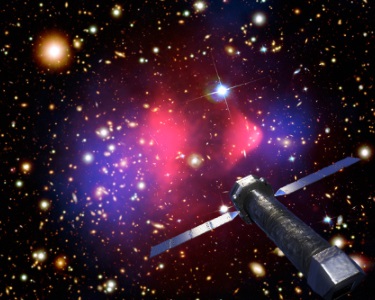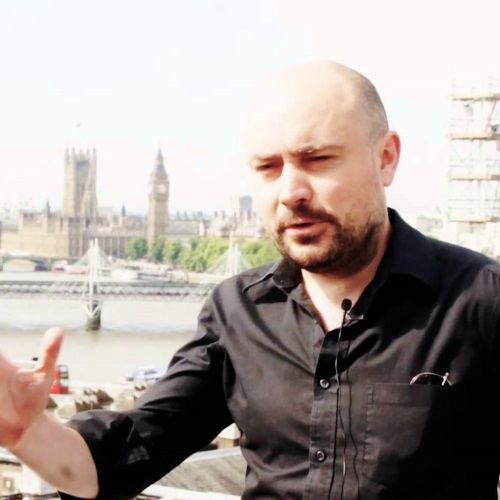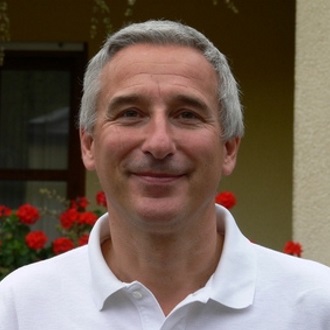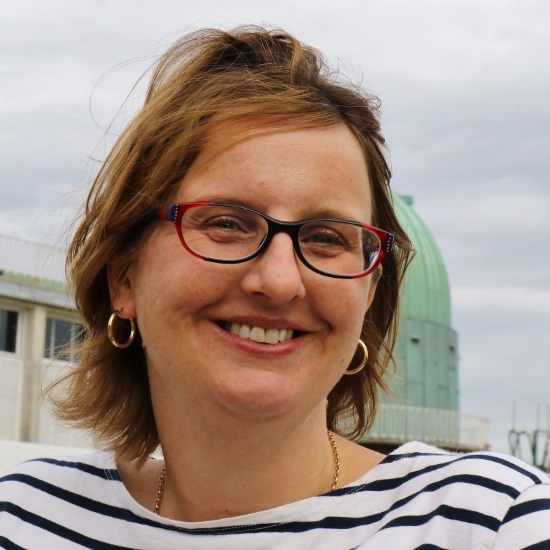Links to external sources may no longer work as intended. The content may not represent the latest thinking in this area or the Society’s current position on the topic.
X-ray astronomy and fundamental physics

Theo Murphy international scientific meeting organised by Professor Joseph Conlon, Dr David Marsh and Dr Helen Russell.
The use of X-ray astronomy for fundamental physics has been seen in two areas; dark matter through the 3.5 keV line, and in searches for axion-like particles. In advance of satellite technological leaps, this meeting brought together astronomy and particle physics communities with a focus on the ability of existing and future X-ray observatories to search for and constrain fundamental physics. It explored the opportunities open to astronomers to probe fundamental physics with both existing archival data and also with future satellites such as ATHENA.
The schedule of talks and speaker biographies are available below. Recorded audio of the presentations will be available on this page after the meeting has taken place.
Enquiries: Contact the Scientific Programmes team.
Organisers
Schedule
Chair

Professor Malcolm Fairburn, King's College London, UK

Professor Malcolm Fairburn, King's College London, UK
Malcolm Fairbairn works at the intersection of particle physics, astrophysics and cosmology. His interests include dark matter, dark energy, inflation and astroparticle physics. He obtained his PhD from the University of Sussex in 2002 before postdocs in Brussels, Stockholm and at CERN. He has been at King's College London for a decade.
| 09:05 - 09:30 |
The current status of 3.5 keV line and sterile neutrino dark matter
Professor Boyarsky will review the current status of the attempts to figure our the origin of the 3.5 kev line and of sterile neutrino as dark matter candidate. 
Professor Alexey Boyarsky, Leiden University, The Netherlands

Professor Alexey Boyarsky, Leiden University, The NetherlandsProfessor Boyarsky graduated from MIPT in 1995 and got my PhD in 1999. He worked at the Niels Bohr Institute, EPFL (Lausanne), ETH (Zurich) and CERN. Currently he is a professor at Leiden University. He is a theoretical physicist, working in particle and astroparticle physics and cosmology. He is a part of the SHiP collaboration and scientific associate at CERN. |
|
|---|---|---|
| 09:30 - 09:45 | Discussion | |
| 09:45 - 10:15 |
Plasma models and charge exchange
Charge exchange (CX) is the process where an electron is transferred from one atom to another. Here Professor Kaastra considers CX between cold, neutral hydrogen gas and hot plasma. The CX process can give rise to line radiation in the X–ray and other spectral bands. The spectrum for this process is quite different from the normal X–ray emission spectrum from the hot plasma. CX with oxygen ions has been seen in many spectra from Solar System objects. Professor Kaastra shows that the CX process in clusters of galaxies occurring between the hot intracluster gas and cold gas filaments is very effective and produces significant line radiation near 3.5 keV due to interaction with sulphur. Additional evidence for this process in clusters comes from grating spectra of clusters in the oxygen band, as well as from UV spectroscopy. Professor Kaastra concludes this presentation with a brief summary of atomic physics, spectral modelling and calibration issues related to the 3.5 keV band. 
Professor Jelle Kaastra, SRON and Leiden University, The Netherlands

Professor Jelle Kaastra, SRON and Leiden University, The NetherlandsJelle obtained his master's degree in 1981 and his PhD in astronomy at the same university in 1985 with a thesis on Solar Flares.After that he joined SRON, the Netherlands Institute for Space Research in Leiden, first as a postdoc and from 1988 as a permanent staff member. He moved in 1994 with the Leiden branch to Utrecht. He is now senior scientist at SRON, and since 2014 adjunct full professor of high-energy astrophysics at Leiden University. His specialism is high-resolution X-ray spectroscopy of extragalactic sources. He is acting PI of the XMM-Newton Reflection Grating Spectrometer and the Chandra Low Energy Transmission Grating Spectrometer. In addition he has been an ESA-selected member of the Astro-H Science Advisory Council. |
|
| 10:15 - 10:30 | Discussion | |
| 10:30 - 11:00 | Coffee | |
| 11:00 - 11:30 |
X–ray probes of dark matter
Professor Jeltema will discuss the use of X–ray observations to constrain particle dark matter models. In particular, she will review searches for X–ray lines including observations of and constraints on the 3.5 keV line. She will also discuss the use of X–ray observations of galaxies and clusters to constrain dark matter self–interaction. 
Professor Tesla Jeltema, University of California, Santa Cruz, USA

Professor Tesla Jeltema, University of California, Santa Cruz, USATesla is an Associate Professor of Physics at University of California, Santa Cruz. She received her BSc from The College of William and Mary and her PhD in Physics from the Massachusetts Institute of Technology. Her research focuses on observational cosmology and particle astrophysics, including constraints on the nature of dark matter and dark energy and studies of the evolution of galaxies. |
|
| 11:30 - 11:45 | Discussion | |
| 11:45 - 12:00 |
Laboratory X–ray astrophysics with highly charged ions
X–ray observations provide insight into the state and dynamics of a variety of astrophysical plasmas. Its interpretation relies on synthetic spectra which are based on plasma models. Those models, in turn, depend heavily on the accurate knowledge of the underlying atomic processes. A recent Hitomi observation of the Perseus cluster [1] provided an unprecedented high–resolution spectrum. It revealed not only well–resolved lines originating from most abundant highly charged ions, but also uncovered significant shortcomings of present spectral packages SPEX and AtomDB, namely inaccurate energies and atomic–scale processes completely missing from the models. For example, a weak line feature around 3.5 keV found in the spectra of galaxy clusters sparked tremendous interest when it was attributed to a possible dark matter decay process [2]. However, charge exchange between bare sulphur ions and hydrogen, a process not included in spectral models, was found to be a more plausible explanation. This talk will report on laboratory electron beam ion trap experiments that compellingly supported charge–exchange mechanism for 3.5 keV X–ray line [3]. It will further underpin how the incomplete knowledge of atomic processes limits the amount of information that can be extracted from current and next–generation X–ray satellites such as Athena and XRISM. REFERENCES: [1] Hitomi Collaboration, Nature 535, 117–121 (2016) [2] E Bulbul et al, Astrophys. J 789, 13 (2014) [3] C Shah et al, Astrophys. J 833, 52 (2016) 
Dr Chintan Shah, Max Planck Institute for Nuclear Physics, Heidelberg, Germany

Dr Chintan Shah, Max Planck Institute for Nuclear Physics, Heidelberg, GermanyChintan Shah obtained his BSc and MSc in Physics from the M. S. University of Baroda, India, in 2011. After working as an assistant scientist at the Institute for Plasma Research for a year in India, he moved to Germany to obtain his PhD from Heidelberg University. He received his PhD in 2015 where his focus was on the development of X-ray Compton polarimeters and on implementing techniques to study plasma anisotropies. Currently, Chintan is working as a postdoctoral fellow at Max Planck Institute for Nuclear Physics (MPIK) in Heidelberg, Germany. His primary focus is on laboratory astrophysics experiments with an Electron Beam Ion Trap (EBIT) to study underlying atomic processes responsible for the X-ray line formation such as collisional excitation, dielectronic recombination, and charge exchange. Chintan's present interests include benchmarking atomic theory and providing empirical data to improve present spectral models which will be critical in interpreting the high-resolution X-ray spectra that current and future missions such as XRISM and Athena, will yield. |
|
| 12:00 - 12:15 |
Sterile neutrino constraints from Chandra to eROSITA
There is an ongoing debate on the nature of the 3.55 keV emission line in X-ray spectra of astronomical objects. One possible explanation is the decay of 7.1 keV sterile neutrinos, which have been proposed as a candidate for dark matter. The authors performed an independent search for the emission line in X-ray spectra of galaxy clusters obtained from the Chandra observatory data archive. They will also discuss future capabilities of the eROSITA observatory in the search for dark matter. 
Dr Florian Hofmann, Max Planck Institute for Extraterrestrial Physics (MPE), Germany

Dr Florian Hofmann, Max Planck Institute for Extraterrestrial Physics (MPE), GermanyFlorian obtained his master’s degree in physics from the Technical University of Munich (TUM) in 2013. In 2016 he obtained his PhD in astronomy within the International Max Planck Research School on Astrophysics (IMPRS) at the Ludwig Maximilians University (LMU) in Munich. Currently he is working as a Postdoc at the Max Planck Institute for Extraterrestrial Physics (MPE). He has been working on X–ray observations of Galactic and extragalactic X–ray binaries, clusters of galaxies, and most recently the Galactic center with the Chandra and XMM–Newton observatories. He is a member of the galaxy cluster working groups of the eROSITA (planned launch 2019) and ATHENA X–ray observatories. |
|
| 12:15 - 12:30 | Discussion |
Chair

Professor Chris Reynolds, University of Cambridge, UK

Professor Chris Reynolds, University of Cambridge, UK
Professor Chris Reynolds is a theoretical astrophysicist with a broad program of research on the astrophysics of black holes, including the physics of black hole accretion and jets, the astrophysical consequences of black hole spin, and the large-scale influence of black holes on their host galaxies and galaxy-clusters. After obtaining his BA (Theoretical Physics) and PhD (Astrophysics) from the University of Cambridge, Reynolds has spent most of his career in the United States, first as a postdoctoral research associate in JILA at the University of Colorado and then as a Professor at the University of Maryland where he ran a group of students and postdocs working on black hole astrophysics. Reynolds returned to the UK in Autumn-2017 to take up the position of Plumian Professor of Astronomy and Experimental Philosophy at the University of Cambridge.
| 13:30 - 14:00 |
keV Neutrinos and Dark Matter

Professor Kevork N Abazajian, University of California, USA

Professor Kevork N Abazajian, University of California, USAProfessor Abazajian has been working on X-ray astronomy probes of dark matter since 2001, when he and his colleagues published the first detailed estimates for the sensitivity of X-ray telescopes to dark matter decay, and placed the first limits on dark matter decay via X-ray astronomy. Since then, he has worked with cosmological large scale structure surveys, including the Sloan Digital Sky Survey, combined with cosmic microwave background data, to test standard cosmology and its extensions. He has also worked on gamma ray searches for dark matter annihilation and decay, employing existing data and forecasts from the Fermi Gamma Ray Space Telescope and ground-based atmospheric Cherenkov telescopes. With the detection of a candidate dark matter line in the X-ray in 2014, Professor Abazajian has worked on the details of sterile neutrino dark matter production in the parameter space of interest, and its implications for galaxy formation. |
|
|---|---|---|
| 14:00 - 14:15 | Discussion | |
| 14:15 - 14:45 |
CELIBE (collisionally excited lines in blustering environments) dark matter
Professor Profumo introduces models where the dark matter can up–scatter to a heavier, unstable state whose decay produces quasi–monochromatic photons. He describes the minimal set of field theoretic ingredients necessary to this class of models, and the key resulting phenomenology. He then discusses some novel phenomena that might occur in the early universe such as dark matter kinetic re–coupling. 
Professor Stefano Profumo, University of California, Santa Cruz, USA

Professor Stefano Profumo, University of California, Santa Cruz, USAStefano Profumo is a Professor of Physics and Chair of Graduate Studies in the Physics Department at the University of California, Santa Cruz. He is the Deputy Director for Theory of the Santa Cruz Institute for Particle Physics. Profumo earned his MS in Physics from Scuola Normale Superiore, Pisa, Italy, in 2011, and his PhD in Elementary Particle Physics from the International School for Advanced Studies (SISSA/ISAS) in Trieste, Italy, in 2014. He held research positions at the Florida State University and at the California Institute of Technology prior to joining the faculty at the University of California, Santa Cruz, in 2007. Profumo is the author or co-author of more than 160 peer-reviewed publications in the areas of Particle Physics Theory, Cosmology, and High-energy Astrophysics; his work has been cited more than 11,000 times according to Google Scholar. |
|
| 14:45 - 15:00 | Discussion | |
| 15:00 - 15:30 | Tea | |
| 15:30 - 16:00 |
X–ray, SZ & dark matter in galaxy clusters
Galaxy clusters are the nodes of the Cosmic Web, constantly growing through accretion of matter along filaments and via occasional mergers. Their matter content reflects that of the Universe (85% dark matter, with visible baryons distributed among X–ray emitting plasma – about 12% of the total mass – and galaxies –3%). Clusters are thus excellent laboratories for probing the physics of the gravitational collapse of dark matter and baryons, and for studying the non–gravitational physics that affects their baryonic component. Professor Ettori will revise the present constraints on the hot plasma, the dominant baryonic component in galaxy clusters, in the regions approaching the virial radius from his team’s ongoing X–COP project, what are the open questions on the properties of this intracluster medium there, and how we can try to characterize it with the future generation of X–ray telescope like Athena, the second L–class mission of the ESA Cosmic Vision program. In doing this, he will touch most of the topics covered from the workshop, like X–ray searches for dark matter, the Particle physics models with X–ray signature, and the Future capabilities of X–ray satellites. 
Professor Stefano Ettori, INAF - Astronomical Observatory in Bologna, Italy

Professor Stefano Ettori, INAF - Astronomical Observatory in Bologna, ItalyDr Stefano Ettori is currently “Primo Ricercatore” at INAF Astronomical Observatory in Bologna, where he is staff research scientist since 2004, and Research Associate at INFN Bologna. Since 2013, he is a co-chair of the scientific working group on the “Astrophysics of galaxy groups & clusters” for the ESA Large mission Athena, the next generation X-ray observatory dedicated to the investigation of the Hot & Energetic Universe. In the past years, he has been Fellow at ESO, Garching (Germany; 2001-2004) and Research Associate in the X-ray Group at the Institute of Astronomy of the University of Cambridge (UK; 1998-2001), where he has also taken his PhD in Astronomy in 1998. Dr Ettori works on the formation and evolution of Groups and Clusters of Galaxies, focusing his activities on two main topics: the physical properties of the Intra-Cluster Medium from the core to the outskirts where mass accretion is occurring; the use of Galaxy Clusters as cosmological probes through the measurement of their baryonic and dark matter content. |
|
| 16:00 - 16:15 | Discussion | |
| 16:15 - 16:30 |
Investigating a potential temperature–dependence in the presence of an unidentified emission line in the spectra of XMM–Newton galaxy clusters
Sunayana is currently writing a paper following the methodology outlined in Bulbul et al (2014), using data from the XMM Cluster Survey. Her team is hoping to use the highest quality cluster data to search for an unidentified emission line, which could point towards the presence of a sterile neutrino dark matter candidate. In particular, they hope to improve on recent works by investigating a temperature dependence on the prominence of the signal – exploiting the fact that the cluster temperature as a strong correlation with the overall cluster mass. An additional motivation for this is to diminish crowding of the weak signal from astrophysical emission lines, as these lines are less prominent at higher temperatures. 
Sunayana Bhargava, University of Sussex

Sunayana Bhargava, University of SussexSunayana Bhargava is a PhD student at the University of Sussex. Her work primarily focuses on observations of galaxy clusters using multi–wavelength data. Previously she has worked on combining X–ray data from XMM–Newton with optical data from the Dark Energy Survey (DES) to understand biases in the measurement of cluster masses from weak lensing techniques. She is currently working on using a large sample of spectral observations from the XMM Cluster Survey to search for an unidentified emission line, which could point towards the existence of a new dark matter candidate. |
|
| 16:30 - 16:45 |
XMM-Newton's impact on fundamental physics
With about 360 refereed papers published each year, XMM–Newton is one of the most successful scientific missions of ESA ever. XMM–Newton observations are pioneering several aspects of fundamental physics, eg 3.5 keV line, searches for axion–like particles, constraining the equation of state (EoS) of cold and dens nuclear matter (in neutron stars), constraining the (EoS) dark matter and testing general relativity near massive objects. The main focus of the talk will be the discussion of scientific highlight results of these topics based on XMM–Newton observations. 
Norbert Schartel, ESA

Norbert Schartel, ESA |
|
| 16:45 - 17:00 | Discussion |
Chair

Dr Andreas Ringwald, University of Hamburg

Dr Andreas Ringwald, University of Hamburg
Dr Ringwald studied Physics at the University of Heidelberg, which was followed by his PhD’s researching “Entropy production, reheating and baryogenesis in the inflationary universe” and “Quantum field theory and the early universe” under supervision of Professor Michael G Schmidt. In 1990 he was a Fellow at CERN were he worked on theory (with Valentin V Khoze) and phenomenology (with Fridger Schrempp and Christof Wetterich) of electroweak instanton-induced baryon- and lepton-number violating processes at very high energies. He continued working at CERN until 1993 when he moved to Deutsches Elektronen-Synchrotron DESY. Dr Ringwald has been a member of the German Committee for Elementary Particle Physics KET, the Executive Board of the Collaboration Research Center SFB 676 Particles and Scientific Board of DESY. In additional to being an editor of Physics Letters B (Elsevier, The Netherlands), he was a visiting Professor at the Institute of Particle Physics Phenomenology in Durham University and Head of the ALPS group at DESY.
| 09:00 - 09:30 |
Simulating axion miniclusters

Dr Javier Redondo, Ludwig Maximilian University of Munich, Germany

Dr Javier Redondo, Ludwig Maximilian University of Munich, GermanyJavier Redondo was born in Zaragoza Spain and graduated in Physics in the University of Zaragoza, Spain, in 2002. Obtained his PhD in Theoretical Physics in the Autonomous University of Barcelona by 01/06/2007 with a thesis titled "Can the PVLAS particle be compatible with the astrophysical bounds?”, that granted the extraordinary PhD prize in the field of Physics that year. He continued his research in the field of low mass particles beyond the standard model of particle physics while hired as postdoctoral fellow in the theory group of the Deutsches Synchrotron (DESY) Hamburg, Germany and the Max Planck Institute for Physics in Munich, both in Germany. He is currently Ramón y Cajal fellow in the University of Zaragoza and continues his research, mostly involved in discovering the elusive QCD axion. |
|
|---|---|---|
| 09:30 - 09:45 | Discussion | |
| 09:45 - 10:15 |
Axions and X–ray polarimetry
X–ray telescope observations have already placed world leading bounds on the axion–photon coupling by searching for axion–photon interconversion in the magnetic fields of galaxy clusters. However, current X–ray telescopes are unable to exploit one of the most striking features of this effect: only photons polarised parallel to the background magnetic field mix with axions. This leads to distinctive polarisation signatures from astrophysical sources. The next generation of polarising X–ray telescopes could detect these signatures. Dr Day will discuss the opportunities and difficulties of detecting axions with X–ray polarimetry. In particular, she considers polarimetry observations of bright point sources in or behind galaxy clusters. The polarisation spectrum is affected by both the properties of the source and by any axion–photon interconversion in the cluster's magnetic field. She will outline characteristic features of axion induced polarisation, and discuss promising targets for detecting these features. Dr Day will present projected bounds on the axion–photon coupling from upcoming missions. X–ray polarimetry has the potential to probe unexplored axion parameter space, and will allow us to search for a new kind of axion signal. 
Dr Francesca Day, University of Cambridge, UK

Dr Francesca Day, University of Cambridge, UKFran completed her PhD in theoretical physics at Oxford, before moving to DAMTP as a Junior Research Fellow at Peterhouse, Cambridge. She is interested in particle phenomenology and in using astrophysical observations to search for new fundamental physics. Her PhD research focused on analysing X-ray telescope data to search for astrophysical signatures of axions. She has also explored how recently observed anomalies at 3.5 keV could be explained by new fundamental physics. Fran is interested in the potential of next generation telescopes to search for and constrain axions and other Beyond the Standard Model physics. Outside of research, Fran is an active science communicator and science comedian. |
|
| 10:15 - 10:30 | Discussion | |
| 10:30 - 11:00 | Coffee | |
| 11:00 - 11:30 |
Radio signatures from conversion of axion–like particles to photons
Axion–like particles (ALPs) can convert into photons in several different ways: in an external magnetic field (known as the Primakoff effect), by decay into two photons, or through parametric amplification of incoming radio photons in an oscillating ALP field within a narrow frequency range. For non–relativistic ALPs all three effects can give rise to radio lines, in particular from astrophysical objects with strong magnetic fields or from regions with ALP over–densities, such as ALP stars. Professor Sigl gives a short overview over estimated intensities and prospects for detectability of such radio lines. 
Professor Guenter Sigl, University of Hamburg, Germany

Professor Guenter Sigl, University of Hamburg, GermanyGuenter received his PhD from Ludwig-Maximilians-Universität München in 1993 with a thesis on non-linear neutrino oscillations. From 1993 until 1999 he was a postdoc at University of Chicago where he started to work on ultra-high energy cosmic rays and various aspects of the early Universe and cosmology such as primordial magnetic fields. In 1999 he moved to Paris for a permanent job as a researcher with the french Centre National de la Recherche Scientifique where he continued studies on astroparticle physics. Finally, in 2007 he became full professor in the II Institute for theoretical physics at the University of Hamburg. |
|
| 11:30 - 11:45 | Discussion | |
| 11:45 - 12:00 |
New constraints on ALPs from a deep Chandra grating observation of NGC 1275

Professor Chris Reynolds, University of Cambridge, UK

Professor Chris Reynolds, University of Cambridge, UKProfessor Chris Reynolds is a theoretical astrophysicist with a broad program of research on the astrophysics of black holes, including the physics of black hole accretion and jets, the astrophysical consequences of black hole spin, and the large-scale influence of black holes on their host galaxies and galaxy-clusters. After obtaining his BA (Theoretical Physics) and PhD (Astrophysics) from the University of Cambridge, Reynolds has spent most of his career in the United States, first as a postdoctoral research associate in JILA at the University of Colorado and then as a Professor at the University of Maryland where he ran a group of students and postdocs working on black hole astrophysics. Reynolds returned to the UK in Autumn-2017 to take up the position of Plumian Professor of Astronomy and Experimental Philosophy at the University of Cambridge. |
|
| 12:00 - 12:15 |
Terrestrial axion/ALP searches
Dr Ringwald will review the different methods to detect axions and ALPs in terrestrial experiments. He will report on their current status and their future prospects. 
Dr Andreas Ringwald, University of Hamburg

Dr Andreas Ringwald, University of HamburgDr Ringwald studied Physics at the University of Heidelberg, which was followed by his PhD’s researching “Entropy production, reheating and baryogenesis in the inflationary universe” and “Quantum field theory and the early universe” under supervision of Professor Michael G Schmidt. In 1990 he was a Fellow at CERN were he worked on theory (with Valentin V Khoze) and phenomenology (with Fridger Schrempp and Christof Wetterich) of electroweak instanton-induced baryon- and lepton-number violating processes at very high energies. He continued working at CERN until 1993 when he moved to Deutsches Elektronen-Synchrotron DESY. Dr Ringwald has been a member of the German Committee for Elementary Particle Physics KET, the Executive Board of the Collaboration Research Center SFB 676 Particles and Scientific Board of DESY. In additional to being an editor of Physics Letters B (Elsevier, The Netherlands), he was a visiting Professor at the Institute of Particle Physics Phenomenology in Durham University and Head of the ALPS group at DESY. |
|
| 12:15 - 12:30 | Discussion |
Chair

Professor Kathy Romer, University of Sussex, UK

Professor Kathy Romer, University of Sussex, UK
Professor Kathy Romer, originally from Tyneside, got her Bsc in Physics with Astrophysics from the University of Manchester in 1990 and her PhD in Astrophysics from the University of Edinburgh in 1995. She then moved to the USA and was a postdoctoral researcher at Northwestern University and at Carnegie Mellon University (CMU). After a short time as a research professor at CMU, she secured a tenure track position there. She moved back to the UK in 2004 to take up a lectureship at the University of Sussex. She is still at Sussex and is now Professor of Astrophysics, Director of the Sussex Astronomy Centre, and a Public Engagement Fellow for the Science and Technology Research Council. Kathy is a world expert in the discovery and exploitation of X-ray clusters of galaxies. She is principle investigator of the XMM Cluster Survey collaboration and is coordinating the cluster research for the international Dark Energy Survey project.
| 13:30 - 14:00 |
Prospects for XRISM – the successor to Hitomi
XRISM, the X–Ray Imaging and Spectroscopy Mission, is the successor to the JAXA/NASA/ESA mission Hitomi. Scheduled for launch around 2021, XRISM will be the premier high spectral resolution astronomy mission for the next decade, and there are high expectations for it to deliver on the promise of in–orbit X–ray microcalorimetry science demonstrated by Hitomi before its untimely demise. XRISM's primary instrument, Resolve, will closely replicate the performance of Hitomi/SXS, and early laboratory tests have validated expectations. The mission will also carry a large–area soft X–ray imager (Xtend). Dr Gandhi will review the status of the mission, novel science prospects, and ongoing community efforts in high spectral resolution X–ray astronomy. 
Dr Poshak Gandhi, University of Southampton, UK

Dr Poshak Gandhi, University of Southampton, UKDr Poshak Gandhi is Associate Professor at the University of Southampton. Originally hailing from New Delhi, India, he researches extreme time–domain astrophysics, with an emphasis on multiwavelength observations of growing black holes. His studies have established the connection between accretion and extreme obscuration in supermassive black holes at the centres of massive galaxies, as well as the causal links between accretion and outflows in relativistic astrophysical jets. He is a member of the NuSTAR and Hitomi science teams, and an Affiliate PI in LSST:UK. |
|
|---|---|---|
| 14:00 - 14:15 | Discussion | |
| 14:15 - 14:45 |
Exploring fundamental physics with the Athena X–ray observatory

Dr Jeremy Sanders, Max Planck Institute for Extraterrestrial Physics, Garching, Germany

Dr Jeremy Sanders, Max Planck Institute for Extraterrestrial Physics, Garching, GermanyJeremy Sanders is a staff scientist at the Max Planck Institute for Extraterrestrial Physics in Garching, Germany, where he uses X–ray observations of clusters of galaxies to understand the physical processes taking place in them. He is interested in many aspects of galaxy clusters physics, but particularly in feedback by active galactic nuclei (AGN). Jeremy is part of the German collaboration working on the forthcoming eROSITA all–sky X–ray survey. He is a co–chair on the topical panel for AGN feedback in galaxy clusters and groups for the planned Athena X–ray observatory, and is also a member of the science team for its Wide Field Imager instrument. Before moving to Germany, Jeremy worked at the Institute of Astronomy in the University of Cambridge. |
|
| 14:45 - 15:00 | Discussion | |
| 15:00 - 15:30 | Tea | |
| 15:30 - 16:00 |
X–Ray polarimetry and fundamental physics

Dr Enrico Costa, Istituto di Astrofisica e Planetologia Spaziali, Italy

Dr Enrico Costa, Istituto di Astrofisica e Planetologia Spaziali, Italy |
|
| 16:00 - 16:15 | Discussion | |
| 16:15 - 17:00 | Roundtable discussion |



